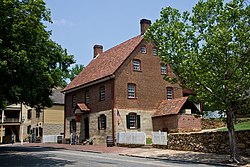Old Salem Historic District | |
 Winkler Bakery at Old Salem | |
| Location | Between Race Street, Old Salem Road, Horse Street and Brookstone Avenue and including parts of God's Acre and buildings along the east side of Church Street, in Winston-Salem, North Carolina |
|---|---|
| Built | 1766 |
| Architectural style | Germanic in early years, slowly shows English/American influence (i.e., Federal and Greek Revival period architecture) |
| NRHP reference No. | 66000591 |
| Significant dates | |
| Added to NRHP | November 13, 1966[1] |
| Designated NHLD | November 13, 1966[2] |
Old Salem is a historic district of Winston-Salem, North Carolina, United States, which was originally settled by the Moravian community in 1766.[3] It features a living-history museum which interprets the restored Moravian community. The non-profit organization began its work in 1950, although some private residents had restored buildings earlier. As the Old Salem Historic District, it was declared a National Historic Landmark (NHL) in 1966,[2][4] and expanded fifty years later.[5] The district showcases the culture of the Moravian settlement in the Province of North Carolina during the colonial 18th century and post-statehood 19th century via its communal buildings, churches, houses and shops.[6]
Two buildings are individually designated as NHLs: the Salem Tavern and the Single Brothers' House. Additional buildings and properties have been added to the National Register to expand the historic area (see St. Philips Moravian Church below, Single Brothers Industrial Complex Site and West Salem Historic District). Ownership of the buildings and land is divided among Old Salem, Inc., Wachovia Historical Society, private owners, Salem College, Salem Academy and Salem Congregation (the successor to the Salem Congregational Council, to whom all ownership of Church properties was transferred).
- ^ "National Register Information System". National Register of Historic Places. National Park Service. January 23, 2007.
- ^ a b "Old Salem Historic District". National Historic Landmark summary listing. National Park Service. Archived from the original on June 20, 2009. Retrieved February 26, 2008.
- ^ "Moravian Archives". Retrieved March 26, 2019.
- ^ Polly M. Rettig and Horace J. Sheely Jr. (June 15, 1976). "National Register of Historic Places Inventory-Nomination: Old Salem Historic District". National Park Service. and Accompanying photos, exteriors and interiors, from 1969 and other dates (5.35 MB)
- ^ "National Historic Landmark Nomination" (PDF).
- ^ Shirley, Michael (1997). From Congregation Town to Industrial City. NYU Press. p. 1. ISBN 978-0-8147-8086-2.

